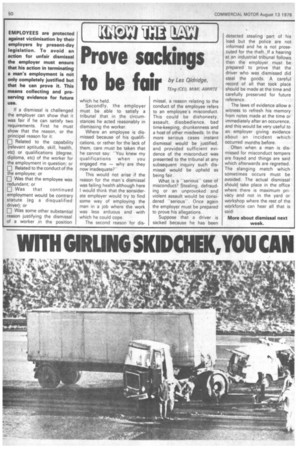Prove sackings to be fair
Page 52

If you've noticed an error in this article please click here to report it so we can fix it.
by Les Oldridge,
TEng (CEI), MIMI, AMIRTE EMPLOYEES are protected against victimisation by their employers by present-day legislation. To avoid an action for unfair dismissal the employer must ensure that his action in terminating a man's employment is not only completely justified but that he can prove it. This means collecting and preserving evidence for future use.
If a dismissal is challenged the employer can show that it was fair if he can satisfy two requirements. First he must show that the reason, or the principal reason for it: O Related to the capability (relevant aptitude, skill, health, etc) or qualifications (degree, diploma, etc) of the worker for the employment in question; or 0 Related to the conduct of the the employee; or O Was that the employee was redundant; or
Ei Was that continued employment would be contrary statute (eg a disqualified driver); or
• Was some other substantial reason justifying the dismissal of a worker in the position which he held.
Secondly, the employer must be able to satisfy a tribunal that in the circumstances he acted reasonably in dismissing the worker.
Where an employee is dismissed because of his qualifications, or rather for the lack of them, care must be taken that he cannot say: -You knew my qualifications when you engaged me — why are they now inadequate?"
This would not arise if the reason for the man's dismissal was failing health although here I woufd think that the sonsiderate employer would try to find some way of employing the man in a job where the work was less arduous and with which he could cope.
The second reason for dis missal, a reason relating to the conduct of the employee refers to an employee's misconduct. This could be dishonesty, assault, disobedience, bad time-keeping, drunkenness and a host of other misdeeds. In the more serious cases instant dismissal would be justified, and provided sufficient evidence of the misconduct was presented to the tribunal at any subsequent inquiry such dismissal would be upheld as being fair.
What is a "seriouscase of misconduct? Stealing, defrauding or an unprovoked and violent assault would be considered "serious". Once again the employer must be prepared to prove his allegations.
Suppose that a driver is sacked because he has been detected stealing part of his load but the police are not informed and he is not prosecuted for the theft., If a hearing at an industrial tribunal follows then the employer must be prepared to prove that the driver who was dismissed did steal the goods. A careful record of all that took place should be made at the time and carefully preserved for future reference.
The laws of evidence allow a witness to refresh his memory from notes made at the time or immediately after an occurence, and this would be very useful to an employer giving evidence about an incident which occurred months before.
Often when a man is dismissed for misconduct tempers are frayed and things are said which afterwards are regretted. The slanging match which sometimes occurs must be avoided. The actual dismissal should take place in the office where there is maximum privacy and not in the yard or workshop where the rest of the workforce can hear all that is said.
More about dismissal next week.




























































































